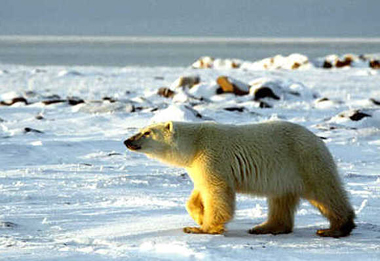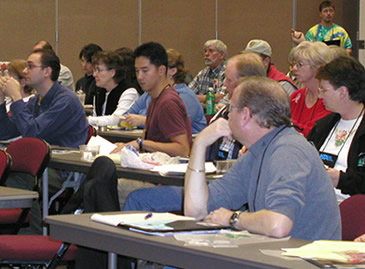Changing Climate, Changing Water Availability, and Human Health
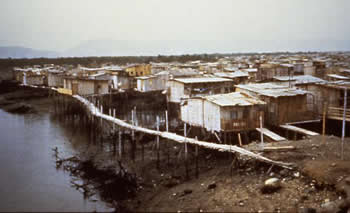 |
An impoverished area of Ecuador in 1992. This area is heavily affected by cholera because of unsafe water sources and lack of sewage treatment. |
Because the world's human population is growing rapidly (it is estimated to be between 8 and 11 billion people within the next 50 to 100 years), and all people need clean freshwater to survive, there will be an increasing human demand on freshwater supplies in the future. Because Earth's climate is warming, freshwater availability may change in the future. Predictions indicate that some regions may have more precipitation, while others may have less. Both situations can lead to changes in human health. Less rainfall may lead to water scarcity. More rainfall may lead to flooding and compromised water treatment systems.
Changes in rainfall, water availability, water quality occurring because of climate change can lead to changes in the risk of both water-borne and water-washed diseases. In some regions, extreme rainfall events will increase the changes of flooding and the risk of water-borne disease. In some regions, conditions are expected to become more arid with increased rates of evaporation limiting water supply and increasing the risk of water-washed disease. Below is information about both water-borne and water-washed diseases and a summary of how climate change can impact their prevalence according to the IPCC Forth Assessment Report on Climate Impacts.
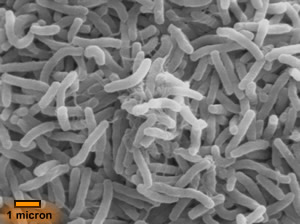 |
Scanning electron microscope image of Vibrio cholerae bacteria, which cause cholera. |
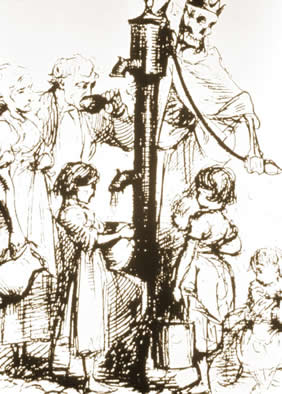 |
This sketch, called "Death's Dispensary", was drawn by George Pinwell in 1866, around the time that the dangers of untreated water became well known. |
Water-Borne Diseases
Water-borne diseases include a variety of ailments that are spread via water containing human or animal waste. Drinking unclean water or eating food that has been cleaned with unclean water can cause a person to ingest the bacteria, viruses or other microbes that cause water-borne diseases. The culprits that may be present in unclean water include well-known bacteria such as E.coli and Vibrio cholerae, the protozoan Giardia, and hepatitis A virus. It does not take a huge amount of contamination to impact human health. According to UNICEF, a mere gram of human feces can contain 10000 viruses, 1000000 bacteria, 1000 parasites, 100 parasite eggs.
For example, the illness cholera is caused when Vibrio cholerae bacteria (see image at left) is consumed. The bacteria produces toxins that irritate the small intestine causing diarrhea. Contaminated water is a primary source of Vibrio cholerae bacteria. Cholera is one of the many bacteria infections, collectively known as "diarrheal diseases", that are prevalent in regions without systems for adequately treating drinking water and dealing with sewage. While diarrhea is, of course, unpleasant, it can be deadly. If the case of diarrheal disease is severe and left untreated the patient can die from dehydration. Rehydration therapy has decreased the number of deaths from diarrheal diseases, yet the diseases are still a problem in many areas of the world.
The science of water-borne diseases was first recognized in the mid-19th century when the link between cholera and London, England's untreated water supply became clear. Today, we are aware of the risks of unclean water, yet safe drinking water is still a problem in many areas of the world. According to UNICEF, diarrheal diseases are responsible for about 17% of deaths among children worldwide.
In Africa, the cholera epidemic has lasted for more than 30 years. In North America, Western Europe, and other locations with advanced water treatment systems, the threat of diarrheal diseases is not normally present. However, diarrheal diseases can become a problem in any region of the world if seasonal changes, storms, or other natural disasters compromise water or sewage treatment systems. After Hurricane Katrina caused levies to fail and massive flooding of New Orleans, LA in the fall of 2005, E.coli levels in the flood waters were of concern and public health officials warned of the threat of diarrheal diseases. At least five people died of diarrheal diseases after the event. The number of reported hazardous events (including severe storms and natural disasters) has increased over the past century (see graph below). There is evidence that weather based extreme events might increase in frequency, intensity, or both as our planet continues to warm, thus increasing the threat of water-borne diseases in the future.
Climate change is expected to change the amount of rainfall in areas of the world and to make areas more prone to extreme rainfall events or extreme drought, according to the IPCC Forth Assessment Report. Extreme events can facilitate water-borne disease outbreaks. Infection with water-borne pathogens has been shown to be higher during the rainy season. Blocked drains, flooded sewers, and other compromised systems during extreme rainfall events can cause an increase in disease. However, there is also evidence that transmission of water-borne diseases can be higher in the dry season. For example, during the low flow dry season in the Amazon, cholera outbreaks are more likely because stagnant water allows more pathogens to come aboard.
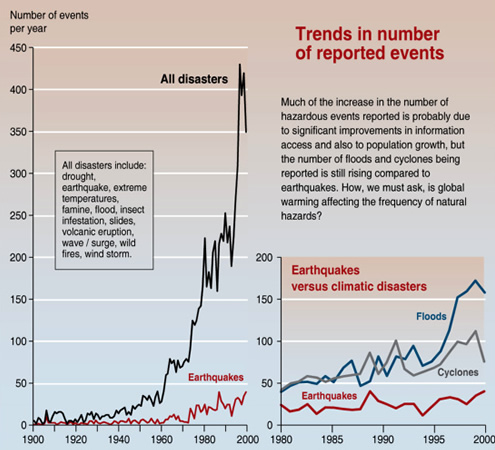 |
The impact of hazardous events is increasing as global population increases. Additionally there is evidence that weather related natural hazards are increasing in number and intensity as climate changes. Events that cause disruption of water treatment systems and sewage systems such as floods, storms, mudslides, fires, and earthquakes can make water-borne illness more of a risk. |
Water-Washed Diseases
In general, washing helps to prevent disease. Diseases that spread because of a lack of washing (i.e., proper hygiene) are called water-washed diseases because they could be washed away. Water-washed diseases include: the eye infection trachoma that causes blindness, skin mites called scabies, conjunctivitis, typhus, and lice.
Preventing water-washed diseases in regions of the world where clean water is readily available usually involves educating people on proper hygiene. However, in parts of the world where water is scarce, there may not be enough clean water for adequate washing of people, their clothing, and homes. And washing with unclean water can also cause disease.More than two billion people live currently in hot and arid regions of the world. In these areas people are more likely to suffer from higher rates of water-washed diseases related to contamination or insufficient water (as well as a variety of other health issues such as malnutrition.) Many regions that are currently arid are projected to become more arid in the future, increasing the risk of water-washed diseases in these areas.
For more information:
- Chapter 8 Human Heath - in the IPCC Forth Assessment Report
- CDC Water-Related Diseases
- UNICEF Voices of Youth
- Cholera FAQs from the CDC
EcoHealth (an excellent web site for students) has the following short articles on climate, water and human health:
- Floods: Water Gone Wild
- Storms: Weather Gone Wild
- Drought: Make it Rain!
- Water Control: Going with the Flow
- Food and Water: Enough for Everyone?
The above, written by Lisa Gardiner, was designed for Understanding Climate Change Today, an online course for educators. Please visit NCAR Online Education for more information about this and other courses.






